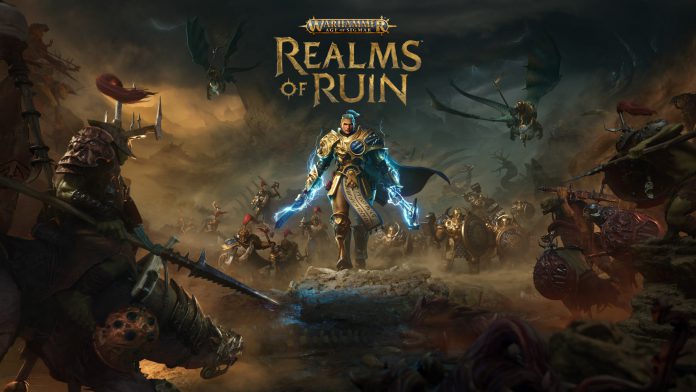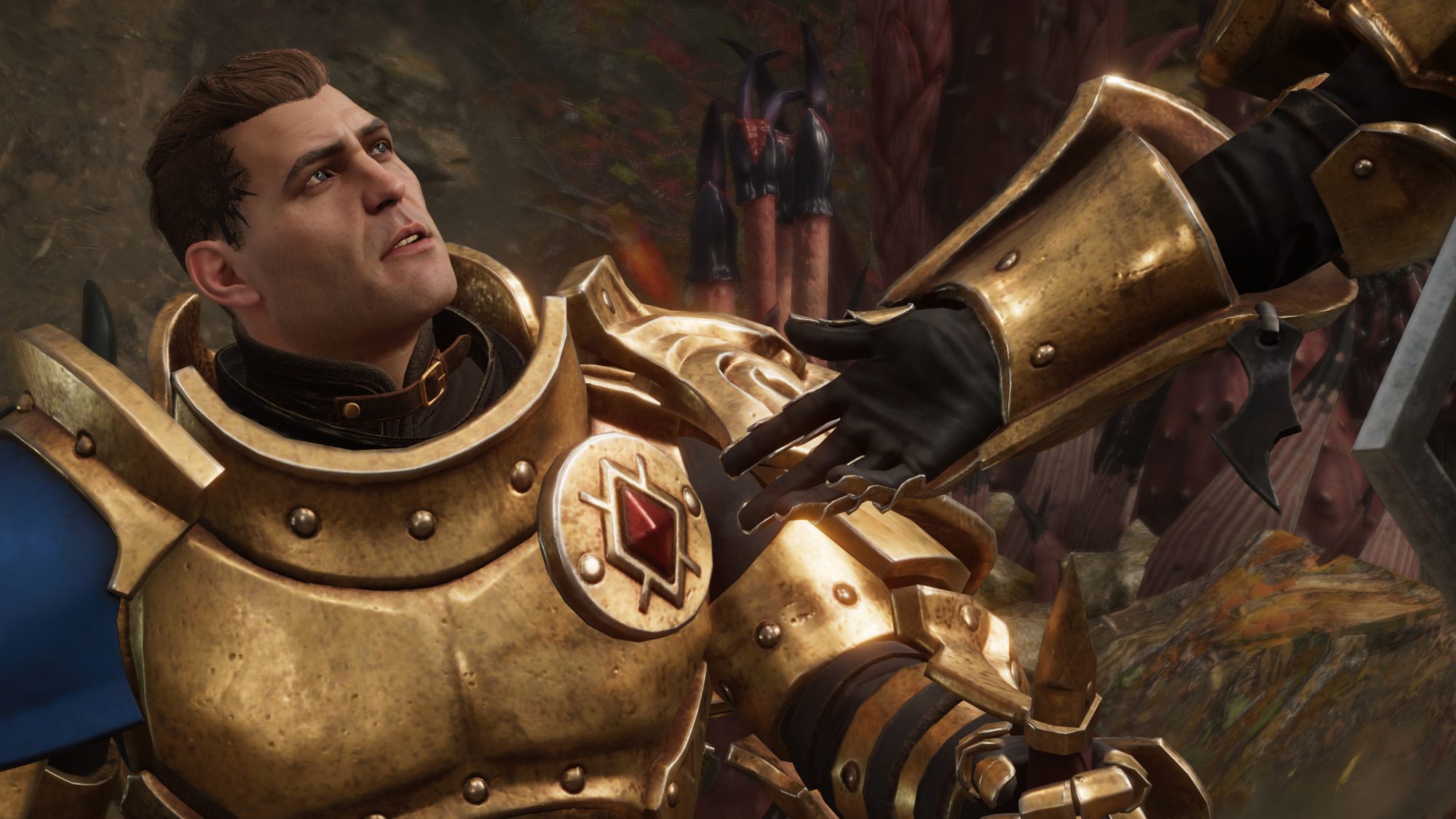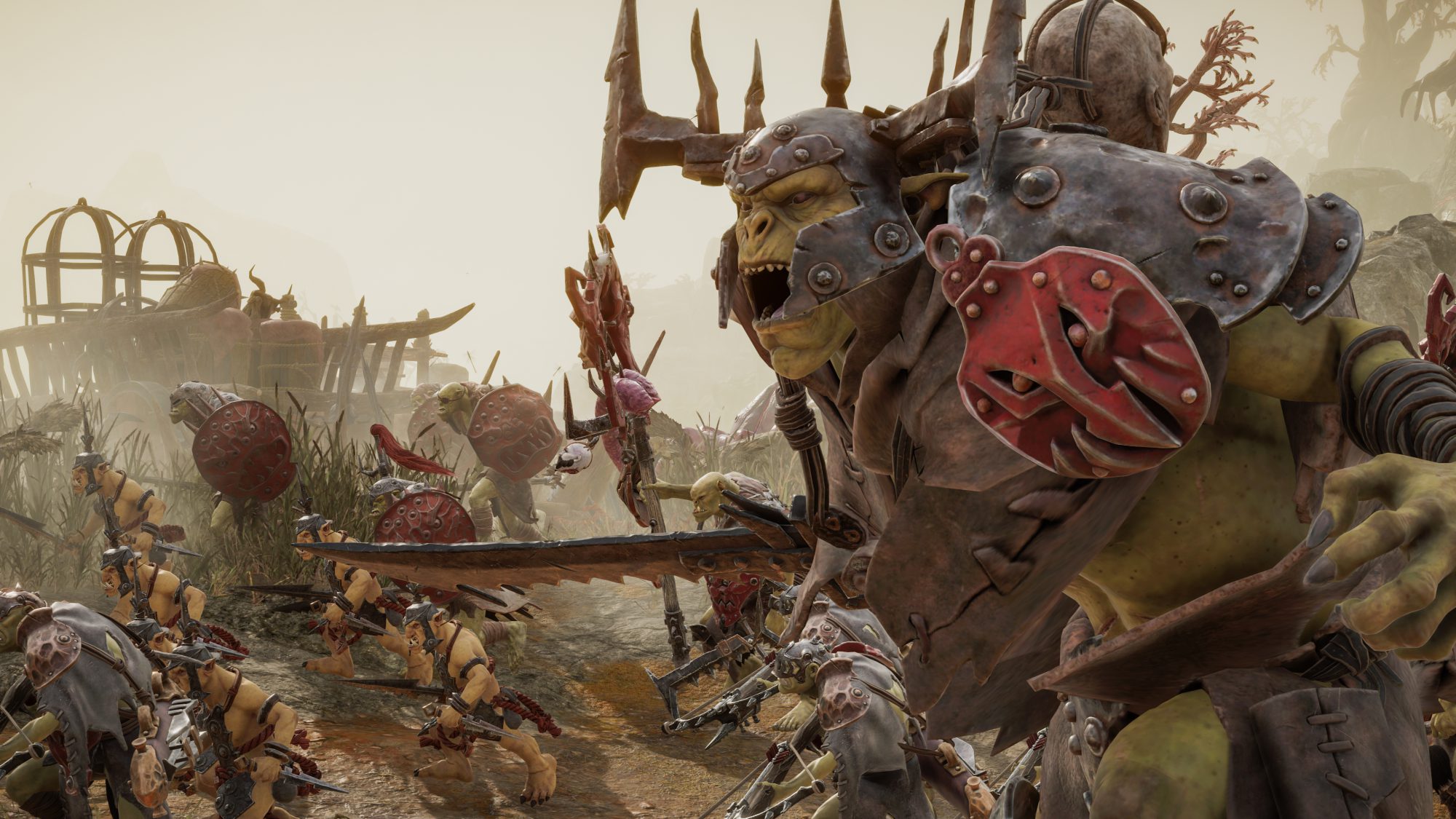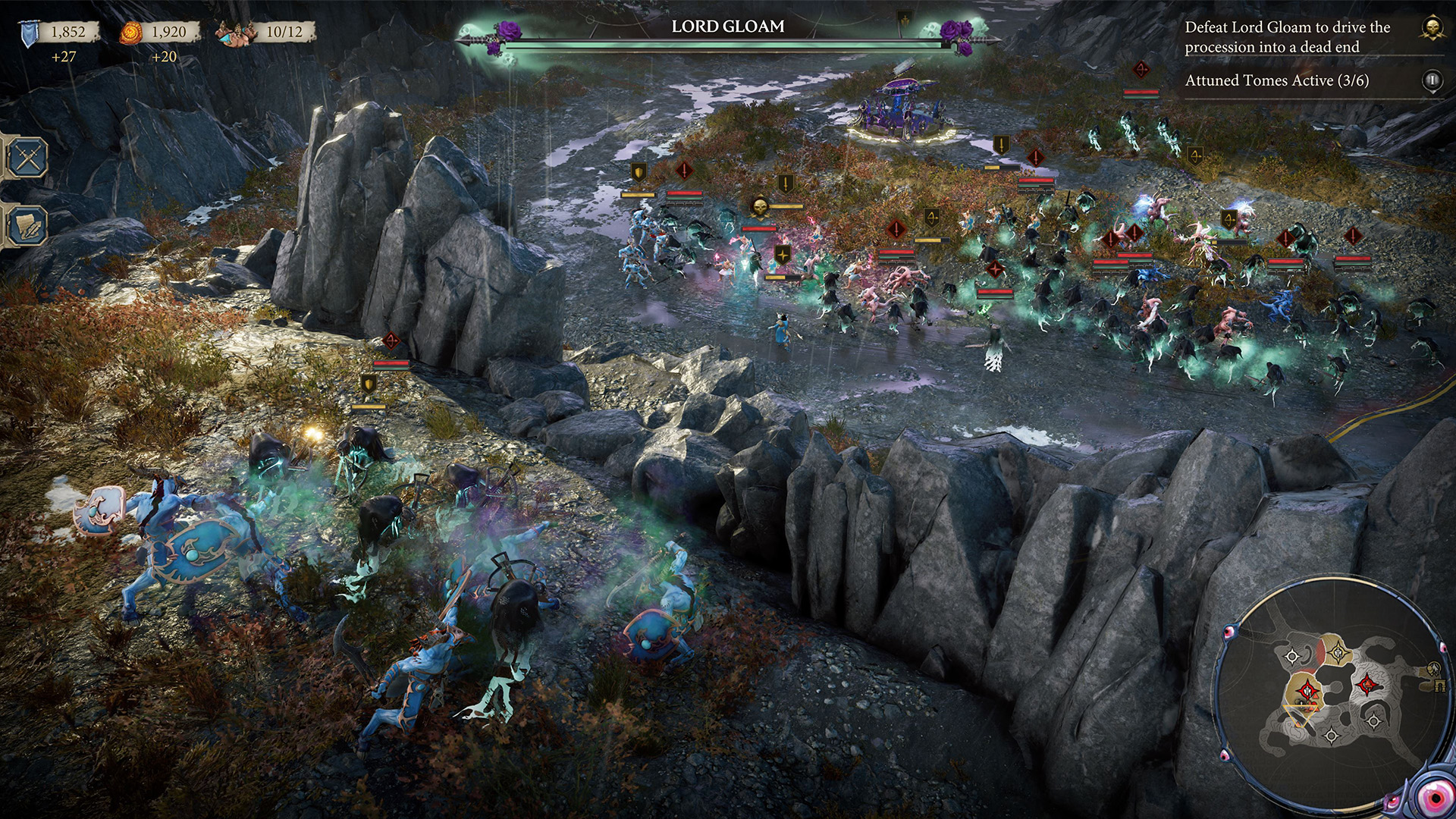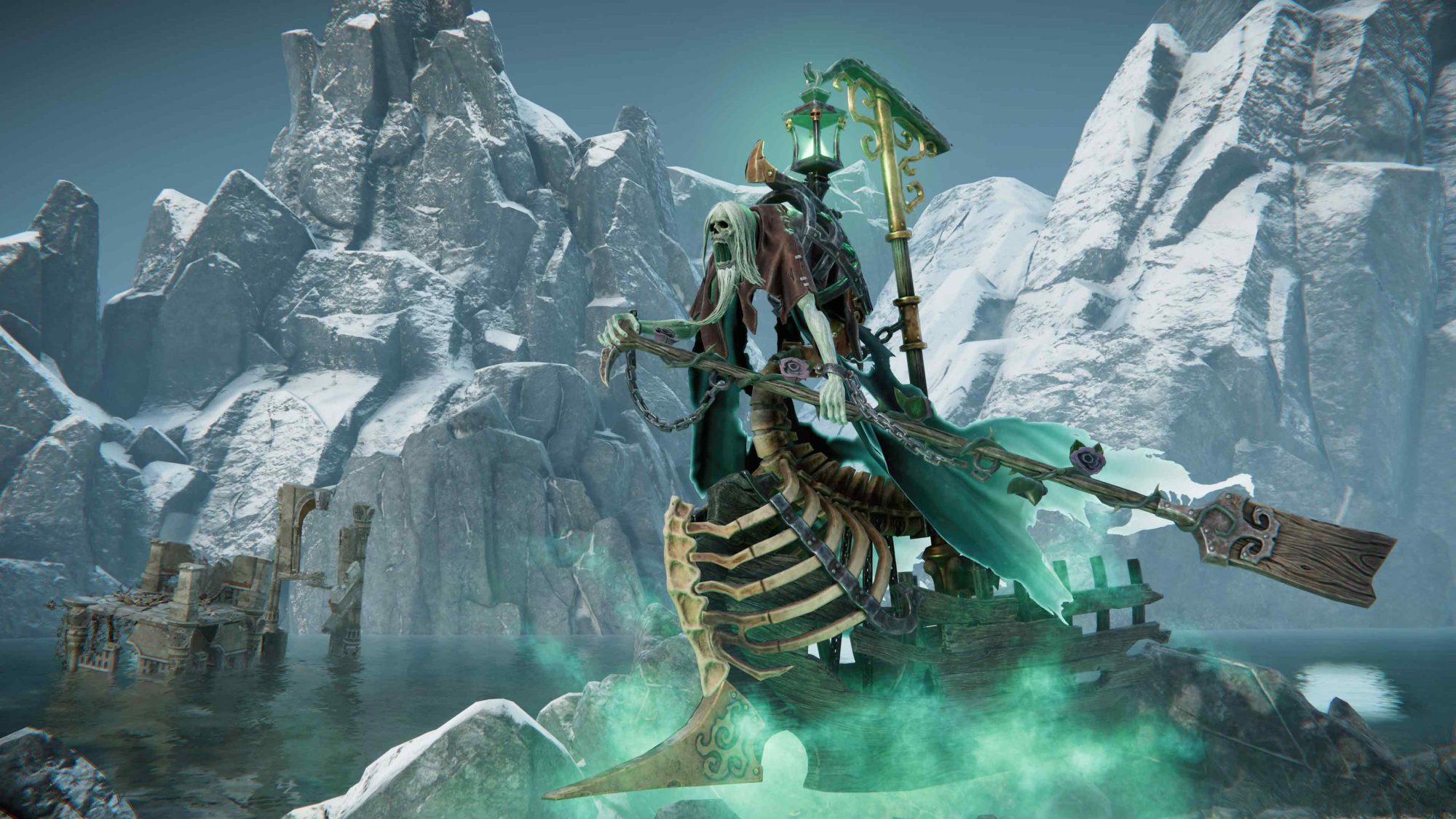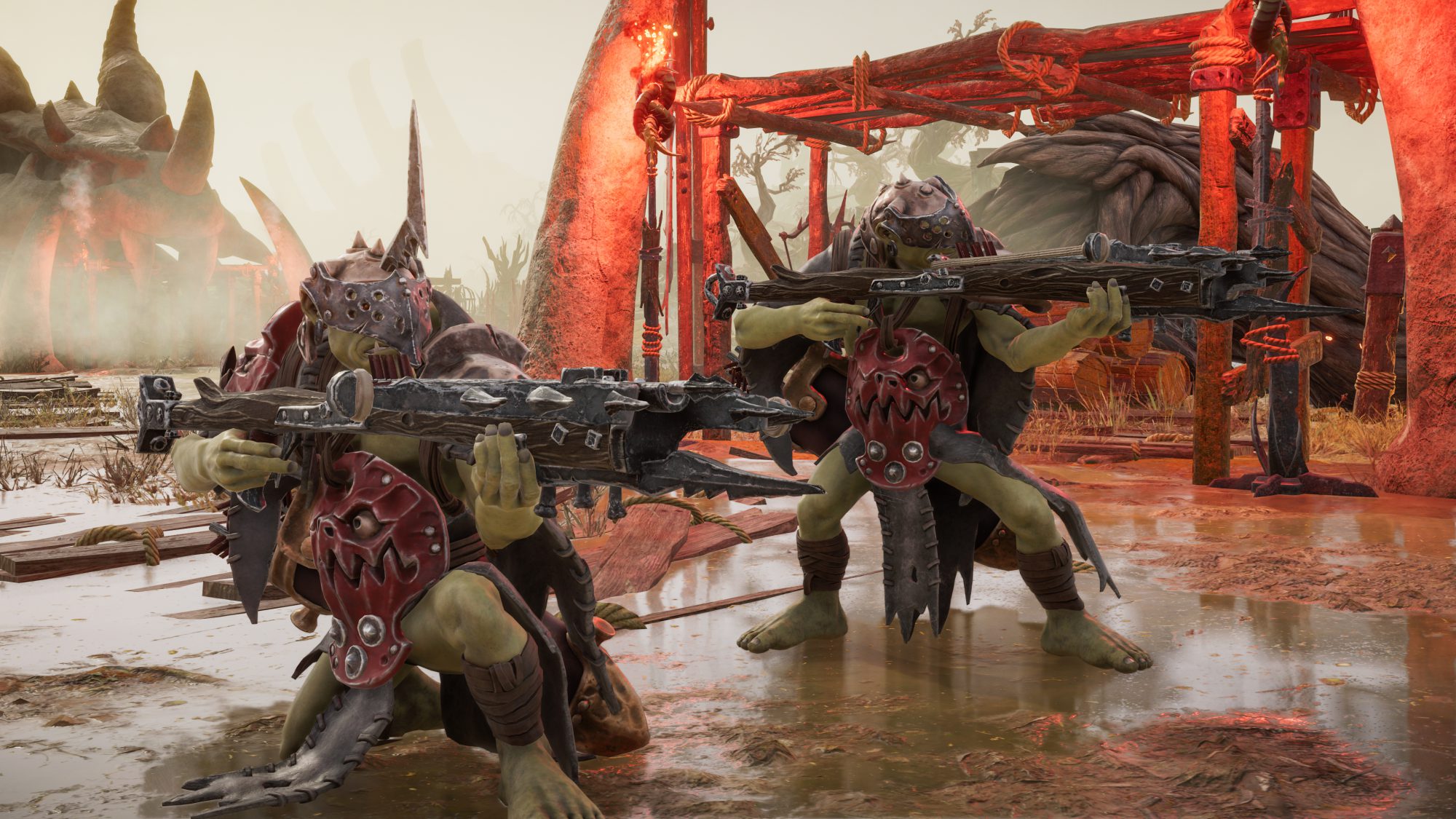We’ve been covering Warhammer Age of Sigmar: Realms of Ruin for a minute now, with multiple hands-on impressions and peeks behind the scenes. Recently, Frontier Developments reached out with an invitation to interview principal designer Sando Sammarco, as well as longtime Black Library author and writer for Realms of Ruin, Gav Thorpe. What follows is a transcription of our half hour interview, edited slightly for clarity.
Campbell McLaughlin: First off, thanks for meeting with me, everybody. While I know who you guys are, our readers might not. Who are you people and how did you get here?
Sandro Sammarco: You want to go first Gav?
Gav Thorpe: OK, so I’m Gav Thorpe. I co-wrote the story for Realms of Ruin. I am a former game designer for Games Workshop, spent 14 years in the games design studio working on 40k, Warhammer, many, many other titles, and for 22 years now, whatever, I’ve also been writing stories for the Black Library imprint of Games Workshop. I’ve freelanced for a decade and a half now but continue to write for Black Library and work on various video games. My history of Warhammer video games goes back to Mark of Chaos; it was the first one I worked on. More recently I did script work for Spacehulk: Deathwing and I also did world design for the For Honor video game.
Sandro: I’m Sandro Sammarco. I’m a principal designer at Frontier Developments, I’ve been at the company for about 16 years now. I’m a bit of a lifer. I’ve worked on a bunch of games. The last big one at Frontier was Elite, and I’m lead designer on Realms of Ruin. It’s been my absolute pleasure to work on this project and and get to work with luminaries such as Gav as well, so it’s all very exciting.
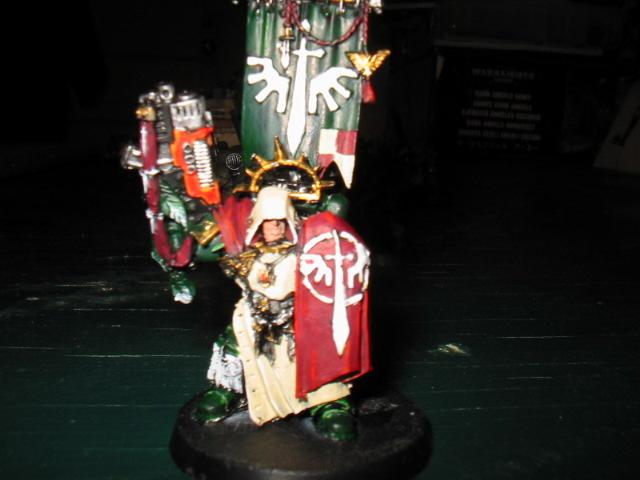
Campbell: Awesome. Gav, thank you for being the reason I started Dark Angels in high school and Imperial Guard in college. I’ve been reading your books since I was 14,
so, thanks for those.
Gav: Thank you for reading them!
Campbell: So, when did the writing process for this game begin and when was Gav brought on?
Sandro: The writing process began relatively early in the project. You know what? I can’t remember the dates now. We got the kind of bare bones skeleton of a story that we worked out with Games Workshop that we wanted to tell, but it was always the case of “We’ll take any help we want.” We love Age of Sigmar, we love Games Workshop’s IP, but we’re always open to getting help from people that have a deeper knowledge of Games Workshop and their IPs. I’m not quite sure how it actually happened, but Gav’s name got floated as a “Well, have you considered working with Gav? He worked on Black Library, he might be up for it,” and we jumped at the chance. It’s like, “Yeah! Yes, please!” And so, when Gav came on board, like I said there was the bare bones of the story, but really it wasn’t till he got his mitts on it that we started crushing it into the thing of beauty that it’s actually become in the end.
Gav: There was a basic story treatment when I came in which was a good story and is still the story that we’ve ended up with. We just sort of took it apart and cleaned out the little bits and reassembled the engine and worked out how it all should actually purr nicely over the following six months. So yeah, I helped with the story treatment. First of all, we got that all approved from Games Workshop and then Sandro and I co-wrote and rewrote the script and then the storyboard guys had suggestions, so we rewrote again. But yeah, it’s been amazing.
Gav: Usually with video games, the writers are kind of, not so much in the last decade or so, but very traditionally reporting quite late and you just write the words in between the missions and that’ll be it. Narrative design obviously has become a thing of itself these days, and even in casual games, narrative is important, so they’ve been lovely enough to include me all the way through. Like we said, he’s working with storyboard guys, working with the audio guys, all the way through to doing the rehearsals for the mocap, working with the actors and director there. Sandro and I and the others like script doctoring on the fly, which was an amazing process, and really useful for me as a writer to see the sausage get made at the other end. They gave you such an insight to the process, so the script work I do in the future hopefully will take that on board. That’s been so much fun. Great team to work with.
Sandro: Yeah, a lot of fun collaborations, it’s been great. I just echo that basically. I’m personally very pleased that we got to work with Gav all the way through because it’s just added value, right up to the point where we were discussing with the actors the classic “What’s my motivation?” and you get to talk about it, and you get to this point where you realize the words that you’ve written are no longer yours. They’re now a thing, and the actor kind of just sucks them in and embodies them, and you go “Oh my God, they’re no longer words, they’re a person!” They’re a person running around doing stuff, and it’s such a fantastic experience without a shadow of doubt.
Campbell: That’s awesome. Script doctoring on the fly sounds immensely stressful.
Sandro: It was fun, actually! It probably was stressful, but it just felt fun because it was very much a case where there was no ego. It was “Oh, could something else work better here?” That line has been read out, it’s been acted, we’re all looking at it and we’re saying “That isn’t quite hitting, I’m not understanding as much,” then it’s just a great collaboration where everyone is pitching in.
Gav: Yeah, and yet no. I think particularly because this was rehearsals and things. You know the mocap? I wasn’t part of that. That’s like, a handful of people, very tight. You know, “get it done.” Whereas this we could just go, “Try growling a bit more on the start of that” or “less of that.” The amazing thing is the actors take on the roles and then suddenly you find the words that you’ve written, and maybe you go “Oh actually yeah, now that I hear it in the actor’s voice or in the character’s voice, that’s not quite right. They wouldn’t say it like that. They would say it like this.” It’s not necessarily stressful, it’s actually really freeing to know that-
Sandro: Liberating.
Gav: What’s gonna come out the other end is actually better by being involved in it because that process will happen. Usually for a writer, you’re not necessarily there in the same room, so who knows what comes out the other end. But actually yeah, understanding that process has been really useful.
For example, let’s talk about the Orruks because you know they were a lot of fun. The actors really got into doing the Orruks, but also just trying to get that balance right. The bestial kind of nature of them and gutturalness, but also understanding you got these very, very professional, well-spoken actors who would like to do these accents and stuff, then saying “Can you rough it up a bit?” You’d have 10% and they’d give you 30% more and you’d be like “That’s amazing, I didn’t realize that was possible.”
Sandro Yeah. It’s worth a quick shout out to the actor that plays Dankfeer, our rather psychopathic Killaboss. That’s Stewart Scudamore. He was brilliant, and with regards to what Gav said, there are a couple of points where his delivery on certain lines – there’s a particular line, I think it’s Dankfeer saying, “Time to get your kill-tools bloody,” it’s a great line, Gav’s line, fantastic line, I love it. In your head you’ve got “It’s time to get your kill-tools bloody,” And then when Stewart did it, it was this crazy foghorn delivery that had a really weird intonation that rose at the end and you kind of go “Whoa, that’s different.” And then you realize “No, that’s Dankfeer.” It’s an amalgam now of all of the words and the acting and the discussion, and it’s a really beautiful moment.
Campbell: I’ve been taking notes while I’m playing through, I’m like 6 or 7 missions in, and yeah, the Orruks calling the Stormcast either stormgits or tinpots. My note is: “I like that the Orruks call you tinpots lol” because yeah, that’s a lot of fun.
Gav: One of the first things I did was I basically compiled a bunch of Orruk speak and ran that past GW, like which ones are we allowed to use, which ones you know–
Sandro: It’s all about the insults.
Gav: And like Stormgits was, yeah, definitely–
Sandro: They liked Stormgits yeah, Stormgits and Tinpots.
Campbell: I’d ask you, which is your favorite faction to write for, or what’s the most fun, but it’s always going to be Orruks. I’d be shocked if it was anything but, although if you do have another answer, I’d love to hear it.
Gav: I don’t know. Which of your babies is your favorite?
Sandro: Yeah, it’s too hard to call. It would be favoritism, and as a parent that would be a terrible thing. I love them all.
Gav: On the face of it, you’d think Orruks were more fun and stuff, but we deliberately went out of our way to get some really nice relationships between Iden and Demechrios in particular. Sigrun is sort of like the last of that triumvirate, their interactions and things. Maybe ‘fun’ isn’t quite the same as you know, getting to do a bit of murderous slapstick with the Kruleboyz, but it’s really satisfying to see them develop from just being a Stormcast commander to actually know this is Sigrun, and this is her particular way of looking at things. We came up with a really nice way to kind of frame them, which was that Sigrun has been reforged a few times, and she’s obviously the most experienced of them. She might become a Lord-Celestant at some point, but she’s kind of looking back. So actually, her perspective is what’s come before and-
Sandro: What she’s lost, what she’s given up.
Gav: Yeah, what she’s potentially lost and what she’s still got to lose. Iden is very much in the moment. He’s a new Stormcast – new, as in, hasn’t been reforged. He’s still pretty much the guy he was back in Shyish. Now he’s just been given this awesome body and armor and a cool banner and he’s like, “You point me and I’ll get it.” Demechrios is the human one, the mortal one, he’s looking forward and understands that at some point he’s not gonna continue onwards. So actually, he’s very much about saving the settlement, about creating what happens after he’s gone and his legacy, which the other two aren’t so bothered about. So that gave us a nice little interplay of motivations, but also when any given thing happens, how do they react to it? How do they look at that scene developing from these three different perspectives. For me as a writer, that’s fun. That’s what qualifies as entertainment when you’re a writer.
Campbell: How do you make these superhuman, or inhuman in the case of the Orruks and Nighthaunt, characters feel human? It sounds like it’s very much by defining their relationships like that.
Sandro: Yeah. You said before, Gavin, it’s about their role. Sigrun is an inspiring Lord-Celestant. She’s a commander. She’s a leader. She’s a battle-hardened warrior. Iden’s a Knight-Vexillor, he’s a champion, he’s like a frontline troop, but then it’s about their motivations. What are they trying to do? And then it’s these kinds of themes that give these little bits of subtext, themes that we put on them about what are they thinking about and it’s, I think Gav you got the right word: satisfying. It’s very satisfying because it goes from a 2-dimensional description of “A Knight-Vexillor is a hero, a champion of the Stormcast who raises his fellow Stormcast back to full health” and that’s great, there’s a lot to that, right? As a champion you expect them to lead from the front, be that bombastic hero, but then you layer on this: He lives in the moment and he’s got a little bit of a sardonic sense of humor, right? Because he hasn’t been reforged, he doesn’t know that pain.
Gav: He’s the ranker, isn’t he?
Sandro: Exactly. It explains to us that he doesn’t exactly take things as seriously.
Gav: A bit. He’s got a lot of soldier humor.
Sandro: He’s bit like a like an NCO, while Sigrun’s been through it. What’s happened to them and what they are helps us inform how they should act. And then we just try and give them a bit of personality so that they’re fun, and they’ll say some cool things. For the Stormcast especially, what was really fun was really hammering home something which Games Workshop have always been open about. The Stormcast are supernaturally powerful, but they’re not infallible. I mean, for a start, there’s a flaw in the very forging process, right? It’s terrible. They’re getting their humanity chipped away, they’re heroes from a bygone era, but they’re not infallible. So, it’s great to have these characters that are bold enough to try and do crazy things, but it doesn’t always work for them. That’s how we get the risk, and I believe for those aficionados that like the Age of Sigmar current 3rd edition lore, it’s not even guaranteed now that they’re going to get back to Sigmar. If they fall, there’s evil magic all over the realms which potentially stops them. Who wants to be physically hammered back into life on some anvil? It’s a terrifying prospect. So, it was really good to make sure that these aren’t like super soldiers that are clones or don’t have any feelings. Each one was handpicked by Sigmar because they were heroes in their past lives. And so, we’ve tried to make sure that they are all suitably different and heroic and fleshed out.
Gav: And same with the Orruks again. Not just positioning them in opposition to the Stormcast, but Dankfeer, you know, he has ambitions. His lands have been invaded. He has his motivations. In terms of writing the Orruks, they’re not just there to be villains for the Stormcast. They have their own things they want to achieve that the Stormcast are stopping them from doing and if certain characters weren’t there, what would be the motion of the setting and how would they interact with it? So, then they come to life as well. They’re not just “Ooh I wanna smash stuff.” It’s like no, actually the way he goes about things is terrible, horrible, murderous, homicidal, just a really horrible thing, but actually what he wants to be is like secure and in charge.
Sandro: He’s got a giant chip on his shoulder.
Gav: He’s actually been exiled once already and has built himself up again, and that’s the other thing. There’s a backstory, they’ve all got history. You know, Dankfeer doesn’t just come to be in the moment that the Stormcast crossed into the marshes and started invading. It’s like, no, he was there already. He has momentum as a character then suddenly these storylines intersect and create the story that we’re telling. And even the Nighthaunt commander, all these characters, even if they’re not massively on screen, we work out that character trajectory and where we’re interacting with that story.
Sandro: What they’ve been doing, yeah, yeah.
Gav: We know where they are, not just what they’re doing, but why they’re doing things and why they’re acting certain ways. I mean, it’s writing innit?
Campbell: Yeah, that’s writing!
Sandro: It’s a lot of fun.
Campbell: That’s the thing, it’s like you have a character walk on for a bit line. They go “Hey, how ya doin’?” You have like a novella on the side about why they’re saying “Hey, how ya doin’?” and why they got here.
Gav: (Laughs) Yeah. But the thing is that the actors sometimes ask as well. That’s the thing, and maybe they don’t even necessarily need the whole back story, but it is a simple thing. Just like, are they excited? Are they angry? Do they want to be there? Because these all affect the way they deliver certain lines. Dovetailing the gameplay and the cinematics and things together so that it feels like it’s a seamless story, where this bit we control because it’s just directed and storyboarded. This bit is the narrative design of the game itself, where the player’s gonna run around and go any number of different ways but towards a fairly given end. We can’t say for sure, like “Aha, that was easy! We breezed through the Orruks!” You have to tell the story in certain ways that the player doesn’t feel like there’s cracks between what they’re doing and what we’re telling them has happened.
And having a good story arc. That was one of the different difficult things. Carrying that story arc through the missions for the different characters is one of the things that helps to do that. It’s like, have they achieved or not achieved what they wanted at the outset, regardless of how the player went about it? Yes? No? OK, cool. Then the story continues.
Campbell: You mentioned earlier the narrative design sometimes comes first before you two were even really writing, is that how this went?
Gav: Umm, not really.
Sandro: It was at the start, the embryo of the story came first and then Gav came aboard and we fleshed it out into the screenplay at the same time, as is often the way with game development. Level design was ongoing, so level design was feeding off of the narrative that we were creating, and also feeding back to us. Yeah, there’s start points and end points, but then the actual gameplay in between. The level design and the narrative design that was done on that, it had to take into account how the motivations of characters or the situation they were in at the beginning and the situation they had to get to by the end. It was a lot of hard work to be brutally honest, but it’s very satisfying. It should feel like the story is gelled. We also made sure that the gaps in between the story where the gameplay occurs, we made sure that they were actually quite cleverly controlled, a controlled environment so that you couldn’t go off and do any old thing. It’s setting those parameters as part of the narrative and the script, so that when you get to the gameplay, you’re on a good trajectory from the beginning. That helps loads. We could have just gone “Well you started this mission, you can do whatever you want” but you’re going to get the mismatch. We know where the characters are going, we know deeply what they’re trying to achieve, and we made sure those goals intrinsically were understandable and legible and kind of straight arrow goals. How you achieved them within the mission; there’s lots of bumps and interesting little changes and twists, but the goal, the momentum of the story doesn’t change. It’s actually a very controlled, tight story. It’s got its moments of bombast, but we wanted to tell a microcosm of what’s happening in the wider world of Ghur with these Dawnbringer Crusades that are going out to colonize this this horrible savage realm. We’re focusing on one of them and we’re saying this is one of the things that can happen. It helped us having those boundaries and that goal, that momentum. It helped us keep on the straight and narrow so the missions flowed from one to the next quite reasonably, but still, yeah, making games isn’t easy.
Gav: Yeah, there’s always give and take. We had the story treatment which had some of the level design. We had some of the things like, there is gonna be an ambush here, there’s gonna be a thing here. So, it’s almost like traditional story beats, but actually the details of it sometimes matter quite a bit. Do they end up standing on the wall defending it, or are they at the gate, or are they there, because that changes the situation that you’re getting to in the cinematics and things like that. There were some adjustments along the way as the actual levels themselves were designed. The script would then, you know, obviously mutate slightly to adapt to that.
Sandro: It could mutate, yeah.
Gav: It’s like, we thought of this, we can do this. Cool, we can incorporate this little element into the level, so therefore we can reference it in the setup that this is a subplot or a thing that’s gonna happen or whatever it might be. That’s the best way – you don’t want to just have set in stone chunks of script and then go into a game and then the script just carries on regardless. But at the same time this isn’t a branching RPG.
Sandro: Yeah, it’s a story.
Gav: It isn’t like, “Iden won’t accompany you in this battle because you annoyed him.” It’s none of that, you know?
Sandro: It’s a story that needs to keep this momentum.
Campbell: Iden isn’t going around stealing all the wheels of cheese in Skyrim or whatever.
Gav: Yeah, yeah, absolutely.
Campbell: Were you two responsible for the little unit barks? Like, when you click on a guy, and they just go like: “Liberators at the ready!”
Gav: (Raises his hand)
Sandro: Gav. It’s an immense amount of work and some of them, I’ve heard them a lot, and after this much time, they still make me laugh. There are some fantastic bangers.
Gav: It’s not just ways of saying “Over here!” but it’s fun. Barks are just an interesting writing exercise. It’s like hey, I left my day office job to fill in a spreadsheet, but again, they’re part of that characterfulness. You know, actually coming up with ten different ways of saying “Move over here” is an interesting exercise in its own right. With some of them it’s really straightforward, but some of them you can have a lot of fun. Sandro, you keep talking about Awlrach and you know he’s a floating boat and stuff. He’s kind of a ferryman, pirate character and stuff.
Sandro: Yeah, he’s fantastic.
Gav: It’s all still part of that storytelling, even within the multiplayer, if you’ve not seen any of that. It’s like when these units from the battlefield are interacting and I’m interacting with them, do I get a sense of who they are, what they are, and their direction?
Sandro: Yeah, worldbuilding.
Gav: There was lots of really good direction that came from Frontier and materials that came from Games Workshop about the style of what the audio and the dialogue would be like, and things that kind of informed those. Some of them we get really into the flow, and some of them is pulling teeth, but that’s just the nature of writing.
Sandro: I’m never gonna get tired of sending Orruk units to die and hearing the Orruk commander say, “Some of da boyz is very dead.” There are just some that are inherently funny and cool. Yeah, there are some cool moments in there as well. It’s great because Age of Sigmar as an IP is very, very serious, but it’s not completely po-faced and there’s leeway for there to be moments of levity, humor. But then it could be sinister, and it could be melancholy. So yeah, a lot of fun. And yeah, Gav’s right, the barks, actually they do a lot of heavy lifting because once the unit starts talking, you kind of get an instant feel. If the writing is good and the acting is good, the direction is good, you’re gonna go “OK, I know this character” and the proof of the pudding has been if you get someone that knows what the character is from the tabletop game. So far, everyone that’s seen and experienced these characters has kind of gone “Yeah, that’s right. That’s what they would say. That’s what they would do” and it’s very satisfying when you get that.
Campbell: I very much appreciate good unit barks. The Warcraft 2, StarCraft 1 unit barks are still lodged in this brain.
Sandro: Oh yeah, because they’re amazing.
Campbell: It’s such an opportunity to fit character in, like you said, even in skirmish play where there’s not a story really reinforcing it. So, what are the challenges of writing Age of Sigmar? Because it is the highest of high fantasy as far as I’ve seen, and you managed to get nicely down in the dirt. There are points where anything’s possible, gods are on the tabletop, duking it out in a fist fight. How do you make that feel grounded, especially if you’ve written, say, 40k or Fantasy or something like that.
Sandro: So that’s a good point. Well, weirdly, maybe serendipitously, I’ve always considered Age of Sigmar to be at the same time, like the highest of fantasy, but also very low file or gritty as well as grimdark. There’s the lifeblood of Warhammer. It’s also this element of grimdark that no matter how clean the armor is, it gets tarnished. So, it actually felt like quite a natural fear. And the other thing we did was we made a good call in making sure the story was quite self-contained. It’s got a start, middle, and end. It doesn’t involve all of the Realms of war with everyone at once, which you can do in Age of Sigmar. But it was very much a ‘what if’ – seriously, like po-faced: What if Age of Sigmar is absolutely real and it can’t just be things happening, Deus Ex Machina because “whatever.” We actually sat down and did the grunt work of going over the logistics and issues you’re gonna run into if you’re taking a wagon train out and setting up a city in the middle of a horrifically dangerous land, and the local indigenous really don’t want you there. How much are you gonna risk, and life and death have to have meaning, right? So, let’s say the Stormcast; they don’t want to die. They’re heroic, and some of the themes we’ve got going in the story are about the inherent nature of heroes and villains and sacrifice and what are you prepared to do to get what you want, and that’s kind of at the heart of it. We just took a very mature look at that. Sigrun is a commander of troops, but she doesn’t want to throw them away willy-nilly, and not just because there’s not many of them, but because she’s not a horrible person. She doesn’t want to get people killed. We’ve tried to make sure the themes run across all of the characters. They’ve got strong motivations and we tried to make them grounded, but you’ve still got some fantastic over the top fight sequences. They’re grounded, but they’re grounded superheroes. Stormcast are humans, but they’re humans dialed up to 11, they really are. They are the kind of people that can jump from the battlements and land on the floor in the hero pose because they’re super strong. And the Orruks are that villainous, right? They will stoop and nothing is too low for them, but we just tried to marry that with kind of grounded motivations.
Gav: Yeah, I think the other key point to that- and it’s something that’s developed a lot more as Age of Sigmar has kind of matured- is the stakes. Let’s say the Dawnbringer Crusades. You have gods and realms and this very high cosmology going on, and literally world-shattering events potentially and things like that. But actually, the viewpoint is from the person on the ground looking up at this stuff, and that’s where we tried to get it. So, the consequences of this failing Dawnbringer Crusade for the people of the city of Harkanibus are all very real. It’s not just some abstract “we have to push back the forces of Chaos.” kind of thing. It’s like, no, these are real people, real lives. The monsters are descending on New York and destroying it, we have to save it, and down to the individual stakes for Sigrun and for Iden and for Demechrios in particular, who very much sees the city as his city. And then on the opposite side are the Orruks. Again, there is stuff at stake, there’s always somebody who’s probably gonna shiv you in the back if you’re not careful. Dankfeer, for all that he is, the terrible creature that he is, there’s stuff at stake for. It’s not evil for the sake of evil, but because there’s things he wants to achieve, and if he doesn’t achieve them, there’s gonna be dire consequences. That’s the low fantasy bit of it. It’s not just gods fighting gods and it doesn’t really matter. The Warhammer archetype is the rat catcher. Who worries about the rat catcher? Well, we don’t actually have the rat catcher, but they’re in the city. They’re still catching rats, and somebody has to save them, you know?
Campbell: They’re in the DLC.
Sandro: (Laughs)
Gav: And that’s what makes the heroes “heroes” then as well. It grounds them, as Sandro says, but actually allows them to be generally heroic because they’re fighting for real motivations and real stakes that people can relate to.
Campbell: Y’all been playing or reading anything good lately? Just quick recommendations on the way out here.
Sandro: I’ve just beaten with a colleague at work the last current boss of Valheim. It’s a fantastic game. I’m just gonna chuck that out, that’s a great game. At the moment I’m playing Payday 3 because it’s on Game Pass, which means I don’t have to pay for it anymore. And who doesn’t want to be a bank robber?
Gav: I’m actually just about to head off to a weekend of playing role playing games – really old-school role-playing games – so I’m looking forward to that. That’s where I’m gonna unwind.
Campbell: Awesome! Sounds like a good victory lap after this.
Thanks again to Gav, Sandro, Anjuli, and the team at Frontier for facilitating this interview. Warhammer Age of Sigmar: Realms of Ruin releases on November 17 for PC, PlayStation 5, and Xbox Series X|S.
Have any questions or feedback? Drop us a note in the comments below or email us at contact@goonhammer.com.
